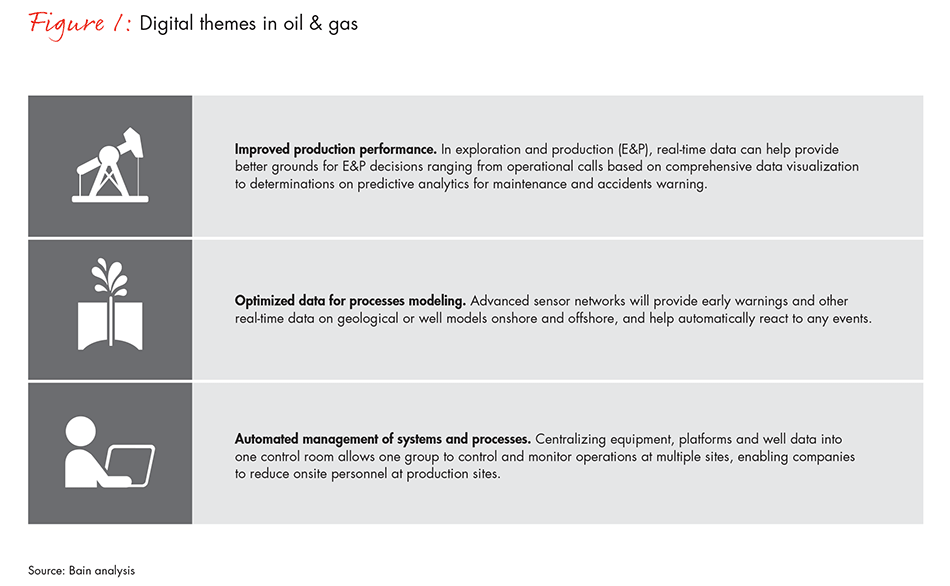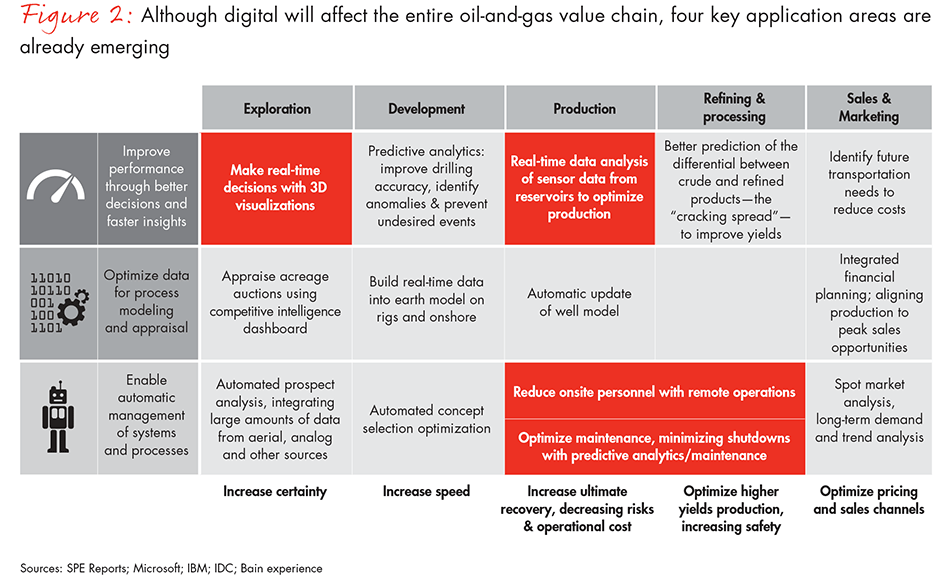論説

Although most oil and gas companies are closely focused on preserving margins to weather the low-price storm, many are also looking ahead and thinking about how digital technologies and data analytics will transform their industry.
Of course, analytics are not new to oil and gas. Unlike other industries that are enjoying a sudden embrace of analytic benefits, energy companies have long depended on rich pools of data to discover and better understand the potential in their reservoirs and other production opportunities. Even so, most have yet to capture the full potential of their data because they haven’t been able to generate actionable insights or make better and faster decisions based on data.
That will change as oil and gas companies upgrade their digital capabilities and improve the way they connect these insights to their operating model. We expect to see dramatic cost savings and significant improvements in productivity and revenue. Cisco estimates companies could see 11% earnings growth across the value chain, with most of the cost savings upstream. One integrated oil company managed to save about 10% on unit costs by digitizing a remote offshore operations center. Another reduced operating costs per barrel by about 10% and improved recoverability of reserves by applying selective applications in intelligent oilfields through collective computing and sharing real-time information at all company levels.
Even so, few have undertaken a structured and holistic approach to identifying which digital technologies can help create long-term sustainable advantage. Most of today’s digital initiatives don’t seek to disrupt operating or business models. Instead, companies are making improvements in technical or operational capabilities. These include predictive maintenance, completed analysis on wells and using geological data from similar oilfields to build geophysical models and choose drilling patterns.
One reason for this incremental approach is that there is already a large, untapped potential in existing data, which companies can use to generate new insights with advanced analysis techniques. Another is that most companies aren’t ready for a big transformation because they lack the people, processes and capital required to make it happen.
Challenges to going digital
Given the challenging economics of the day, oil and gas companies need to put their investments in analytics where they will deliver the most bang for the buck (see Figure 1).

However, in our work, we frequently see companies facing three common challenges that are sure to limit their digital potential over the long term.
- They haven’t developed a multiyear digital strategy. Many companies have ventured into digital investments without a clear understanding of where and when the transformation will bring the most benefit. Without a clear strategic, multiyear path, the risk is very high that companies could invest billions of dollars but only capture a fraction of the benefits. For example, offshore drilling and production can benefit from advanced analytics of reservoir and equipment data, if companies analyze the data to optimize equipment maintenance and minimize operations disruptions. According to Cisco data, a single offshore platform can generate 1–2 terabytes of data per day, but current satellite network bandwidth is extremely limited due to transfer speeds around 2 Mbps, making it impossible for subsurface and operations teams on the mainland to keep up with the available information in real time. In cases like this, the lack of an integrated digital strategy that could have placed analytics resources closer to the data results in missed opportunities to act on information in near real time.
- They haven’t updated their operating model. Too often, companies fail to connect the information flows in ways that will actually improve how the organization operates. But if information doesn’t follow structure, it gets lost. For example, a company might invest in visualizing a scheduling system with sophisticated routing capabilities, but then fail to connect it to the line management’s scheduling decisions. Without those connections, data winds up as stranded information rather than becoming actionable insights.
- They haven’t invested in their people. People are the most important component of a winning digital strategy, yet failing to upgrade their capabilities is the most common pitfall in unsuccessful transformations. Executives should assess their team’s current capabilities and develop a plan to manage change and improve technical expertise. This will involve a combination of recruiting fresh talent (including data scientists and other digitally savvy professionals) and teaching new skills to the operational staff. No one should assume that the front line will automatically embrace new processes and digital technologies. Change-management programs are needed to help them through the dramatic changes under way—for example, learning how and why to use an augmented-reality interface rather than turning to their familiar, dog-eared manual, or exchanging data and communicating in real time with technical experts to evaluate corrosion issues on a pipeline.
Tapping the full potential
Greater changes will come over time, but today most companies are still preparing the groundwork for the larger and more disruptive transformations that will come as oil and gas companies implement a broader range of digital technologies. As they put in place specific digital capabilities that can deliver fast results at reasonable costs, executives need to develop a strategic roadmap encompassing the digital strategy, operating model changes and, most importantly, people capabilities.
Approaches differ, of course, from one company to the next, depending on appetite for risk, potential gains from digital and readiness for the transformation. But they typically include five key elements:
- Identify the areas of the value chain with the highest impact on financial and operating results and cross them with the opportunities to enhance delivery through digital technologies (see Figure 2).
- Monitor key industry and technology trends, focusing on the identified value chain areas that are specific to the operations. Decide whether to lead the industry by innovating or by acting as a fast follower by implementing tested technologies and processes.
- Clearly define the links between the company’s most critical decisions and digital applications, including showing how digital applications will improve decision-making effectiveness. In addition, adjust the operating model to facilitate the sharing of key information, leveraging all available data sources.
- Evaluate the investment necessary to digitize the key activities of the company’s value chain, and develop a multiyear budget and an overall roadmap balancing the capture of economic benefits with the financial burden on the cash flow.
- Assess current personnel capabilities and develop a plan to address the gap. The talent upgrade plan should deal with deficits in technical expertise and include a comprehensive set of actions to instruct those at the front line on how to change their way of working.

Every oil and gas company’s digital journey will differ, depending on their industry position, ambitions and opportunities. Digital leadership is not always the best strategy, and it can be expensive. However, at a time when low oil and gas prices are restricting investment capacity, this is one area of the business where cost has been decreasing and tools rapidly improving—so it should merit an increasing share of budget and focus. But whether a leader or fast follower, every oil and gas company will need to develop a strategic plan for how it will use digital technology to gain a competitive advantage over the next three to five years. All of these plans should include initiatives that offer short-term gains and build capabilities to develop long-term competitive advantage. Perhaps most importantly, they should all include details on how the flow of information necessitates changes to the operating model, and how each company plans to upgrade its talent and capabilities to make the most of its potential.
Lodewijk de Graauw is a partner in Bain’s Perth office and Dmitry Naberezhnev is a Bain partner in Moscow. All three work with Bain’s Global Oil & Gas practice.

